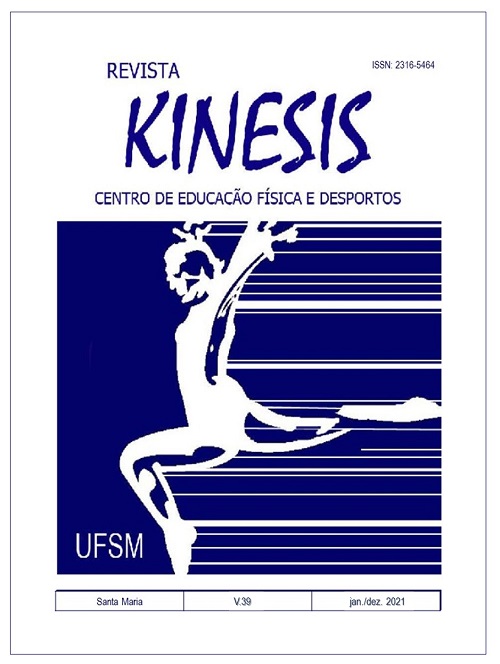Barreiras e facilitadores percebidos por pessoas com deficiência praticantes de esportes
DOI:
https://doi.org/10.5902/2316546463869Palavras-chave:
Pessoas com deficiência, Acessibilidade arquitetônica, Instalações Esportivas e RecreacionaisResumo
Considerando a importância da inserção de pessoas com deficiência no esporte, objetivamos identificar as barreiras e os facilitadores para a prática esportiva de pessoas com deficiência inseridas nos projetos de extensão da Universidade Federal de Santa Catarina (Brasil). Para determinar as barreiras e os facilitadores foi aplicado um questionário a 19 participantes. Usou-se o teste qui-quadrado para avaliar a associação entre barreiras e facilitadores (p<0,05). Os indicadores estatisticamente associados como facilitadores para a prática esportiva de pessoas com deficiência incluem a simpatia e conhecimento profissional, apoio da família e amigos e a ausência de constrangimento à prática. A presença de lesões, o clima e a distância do local da prática foram associados como barreiras. Desse modo, propiciar um ambiente de elevado apoio social, estabelecer cuidados para evitar lesões físicas e oferecer programas esportivos descentralizados, na cidade, parecem ser medidas importantes para a efetiva participação de pessoas com deficiência no esporte.Downloads
Referências
AMARAL FILHO, H.J.A. et al. Barreiras e facilitadores para a prática de atividade física nos atletas do rugby em cadeira de rodas. Centro de Ciências da Saúde, Departamento de Educação Física, PROBEX. Disponível em: http://www.prac.ufpb.br/enex/trabalhos/6CCSDEFPROBEX2013187.pdf Acesso em: 15 fev. 2020.
ANDERSON, L.S; HEYNE, L.A. Physical activity for children and adults with disabilities: an issue of "amplified" importance. Disability and Health Journal, v.3, n.2, p.71–73, apr. 2010.
BECERRA, M.A.G; MANZINI, M.G; MARTINEZ, C.M.S. Percepção de atletas do rugby em cadeira de rodas sobre os apoios recebidos para a prática do esporte adaptado. Cad. Bras. Ter. Ocup, v.27, n.3, p. 615–627, jul/sep. 2019.
BRAGARU, M. et al. Barriers and Facilitators of Participation in Sports: A Qualitative Study on Dutch Individuals with Lower Limb Amputation. PLOS ONE, v.8, n.3, p.1–9, mar. 2013.
BRASIL. Ministério da Saúde (MS). Secretaria de Vigilância em Saúde. Secretaria em Atenção à Saúde. Política Nacional de Promoção da Saúde. Brasília, 2006. 3ª edição.2010. Disponível em: http://bvsms.saude.gov.br/bvs/publicacoes/politica_nacional_promocao_saude_3ed.pdf Acesso em: 20 jan. 2020.
BRITTAIN, I. Perceptions of disability and their impact upon involvement in sport for people with disabilities at all levels. J Sport Soc Iss, v.28, n.4, p.429–452, nov.2004.
CARDOSO, V.D. A reabilitação de pessoas com deficiência através do desporto adaptado. Revista Brasileira de Ciências do Esporte, v. 33, n. 2, p. 529–539, jun. 2011.
COSTA e SILVA et al. Esporte adaptado: abordagem sobre os fatores que influenciam a prática do esporte coletivo em cadeira de rodas. Revista Brasileira de Educação Física e Esporte, v.27, n.4, p.679–687, out/dez. 2013.
CENTRO DE DESPORTOS. Portal CDS, (UFSC). Florianópolis, 2018. Disponível em: https://noticias.ufsc.br/2018/11/pessoas-com-deficiencia-encontram-autonomia-e-estilo-de-vida-saudavel-em-projetos-de-extensao-da-ufsc/ Acesso em: 15 fev. 2019.
ELLIS, R. et al. Physical activity beliefs and behaviour of adults with physical disabilities. Disability and rehabilitation, v.29, n.15, p.1221–1227, aug.2007.
HAYES, S.D; CROCKER, P.R.E; KOWALSKI, K.C. Gender differences in physical self-perceptions, global self-esteem and physical activity: Evaluation of the physical self-perception profile model. Journal of Sport Behavior, v.22, n.1, p.1–14. 1999.
JAARSMA, E.A. et al. Barriers to and facilitators of sports participation for people with physical disabilities: a systematic review. Scand J Med Sci Sports, v.24, n.6, p. 871–881, dec. 2014.
JUNG, L.G; KALINOSKI, A.X; MARQUES, A.C. Barreiras e facilitadores para a atividade física em pessoas com déficit intelectual. Rev Bras Ativ Fís Saúde, v.22, n.4, p.362–372, jul. 2017.
LAMÔNICA, D.A.C. et al. Acessibilidade em ambiente universitário: identificação de barreiras arquitetônicas no campus da USP de Bauru. Rev. Bras. Ed. Esp, Marília, v.14, n.2, p.177–188, mai/ago. 2008.
MARMELEIRA, J. F. F. et al. Barriers to physical activity among people with visual impairment. Revista Brasileira de Ciencias do Esporte, Porto Alegre, v.40, n.2, p.197–204, abr/jun. 2018.
MARTIN, J.J. Benefits and barriers to physical activity for individuals with disabilities: a social-relational model of disability perspective. Disab and Rehabil, v.35, n.24, p.2030–2037, jun. 2013.
RIMMER, J.H. et al. Physical activity participation among persons with disabilities: Barriers and facilitators. American Journal of Preventive Medicine, v.26, n.5, p.419–425, jun. 2004.
SERON, B.B; ARRUDA, G.A; GREGUOL, M. Facilitadores e barreiras percebidas para a prática de atividade física por pessoas com deficiência motora. Revista Brasileira de Ciencias do Esporte, v.37, n.3, p.214–221, jun. 2015.
SCELZA, W.M. et al. Perceived barriers to exercise in people with spinal cord injury. Physical Medicine Rehabilitation, v.84, n.8, p.576–583, aug. 2005.
SHIELDS, N; SYNNOT, A.J; BARR, M. Perceived barriers and facilitators to physical activity for children with disability: a systematic review. Brit J Sport Med, v.46, n.14. p.989–997, sep. 2012.
Instituto Brasileiro de Geografia e Estatística. Censo demográfico 2010. IBGE, 2010. Disponível em: https://www.ibge.gov.br/cidades-e-estados/sc/florianopolis.html Acesso em: 20 ago. 2020.
VAN DER PLOEG, H.P. et al. Physical activity for people with a disability: a conceptual model. Sports Medicine, v.34, n.10, p.639–649, 2004.
VAN DER PLOEG, H.P. et al. Successfully improving physical activity behavior after rehabilitation. The Science of Health Promotion, v.21, n.3. p.153–159, jan/feb. 2007.
World Health Organization (WHO). Disability. 2018. Disponível em: https://www.who.int/health-topics/disability#tab=tab_1 Acesso em: 15 jul.2020.
Downloads
Publicado
Como Citar
Edição
Seção
Licença
Os artigos deverão ser enviados em formato digital da plataforma SEER, através do endereço eletrônico: http://periodicos.ufsm.br/kinesis/index. Em caso de dúvida, entrar em contato com a equipe editorial através do e-mail kinesisrevista@ufsm.br. A autoria que publicar na Revista Kinesis concorda com os seguintes termos:
- Mantêm os direitos autorais e concedem à revista o direito de primeira publicação;
- Permitem e são estimulados a publicar e distribuir seu trabalho online (ex.: em repositórios institucionais ou na sua página pessoal) já que isso pode gerar alterações produtivas, bem como aumentar o impacto e a citação do trabalho publicado
- Em virtude de aparecerem nesta revista de acesso público, os artigos são de uso gratuito, com atribuições próprias, em aplicações educacionais e não-comerciais.







